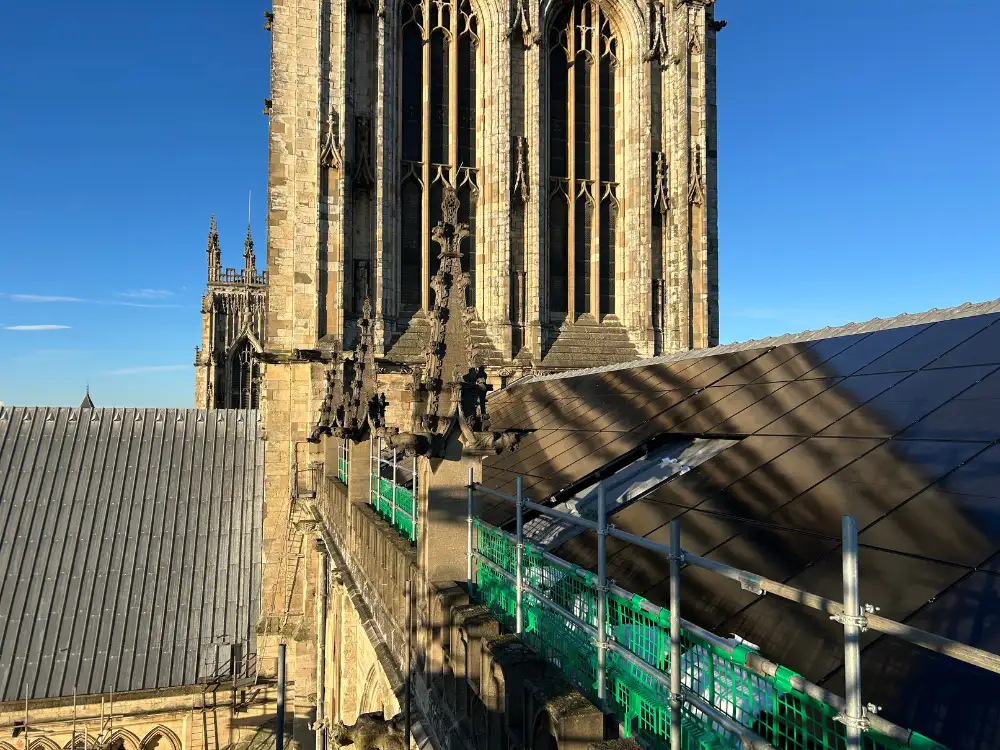As part of their journey to net zero, York Minster has successfully installed 184 solar panels onto the south quire roof of the cathedral.
The anticipated switch on took place earlier today (9 January), following a blessing ceremony led by the Dean of York.
The project is one of many underway as part of the Minster’s Neighbourhood Plan, which has been recognised internationally for its environmental innovation.

The plan is designed to address the challenges of the 21st century, principally responding to the climate emergency and the impacts of climate change on York Minster’s 800-year-old building.
Extreme weather conditions, brought by climate change, is the greatest hazard to the fabric of the cathedral.
Reducing energy
The panels, installed over the last four months, will generate 70,000 kWh of energy, enough to deliver a third of the Minster’s electricity requirements.
This is the fourth solar installation on the Minster estate, with existing solar slates on the York Minster Refectory, solar panels at the Heritage Quad and solar film on the Works & Technology Hub.
These will collectively generate 120,000 kWh of energy per year, which alone is enough to power 41 average UK homes.
Alex McCallion, director of works and precinct at York Minster, is the man behind the vision.
He told YorkMix: “This is a really exciting day for us at the Minster, and it’s the culmination of seven years’ work.

“This is a major project of our Neighbourhood plan, which was adopted in 2022 and sets the planning policy for the care of the cathedral and its estate up to 2035. A core plank of the planning policy in that document is to get us to net zero.”
Alex believes it’s “entirely right” for the cathedral to produce its own power.
“This isn’t a museum, this is a living building, it has got to be fit for purpose for the 21st century,” he added.
Installation
Associated Clean Technologies (ACT) were the team responsible for the installation of the solar panels, a process Mr McCallion described as “relatively straightforward”.
He believes this is down to the detailed planning behind the project.
“The planning, our amazing survey of the fabric, and ACT have all been absolutely fantastic.
“There have been a few little bumps in the road, but nothing major. And I think that’s a sign, it’s such amazing technology that’s advancing all of the time,” Alex told YorkMix.

Balancing act
Due to the nature of the Minster, sustainability efforts need to be balanced very carefully with the historic value of the building.
Maggie Mclean, Canon Missioner at York Minster, feels that despite those who may not have initially agreed to the project, the panels have been installed highly discreetly.
She told YorkMix, “there will have been people that won’t have welcomed this with open arms.
“But, I think technology over the last seven years has progressed so much that it’s possible to install solar panels that you don’t really see. They’ll be very hardly visible from the floor, for a start.”
Maggie hopes that the project will have a large impact on similar buildings across the region, “I think when a place like York Minster commits to really making an impact for sustainability, people sit up and listen,” she added.
Inspiring further projects
Alex feels that the project will encourage others to reduce their energy consumption.
“We hope that we are leading by example, and we hope we will inspire others to do the same.
“And if we can do it on a grade one listed building, a scheduled monument, we hope it inspires others to do the same,” he told YorkMix.
Dominic Barrington, the Dean of York, agrees that the installation will serve as a message to others that similar action is possible.

He told YorkMix, “there is still too much cynicism about the climate emergency”.
“I hope that the installation is recognised not just by other sacred buildings, but iconic secular buildings.
“Whether we’re talking about Parliament or Buckingham Palace, if we can do it, there’s no excuse for it not being explored by those responsible for large, iconic buildings of any kind around the world,” the Dean said.
The next step
The next project, as part of the Neighbourhood plan, will see the delivery of its first low carbon retrofit project.
1 Deangate, in the Minster Precinct, is set to be sustainably refurbished and converted into a new visitor experience headquarters.
It will have solar panels installed, double glazed wooden windows, internal installation, as well as an air source heat pump.
Alex explained, “it’ll be an off grid, deep retrofit project. What’s great about that is it’s domestic in scale, and right next to the cathedral. So tens of thousands of people walk past it every month.”
He hopes that this will inspire local residents to make similar changes to their own homes, through double glazed windows in particular.
For more information on the neighbourhood plan, click here.
